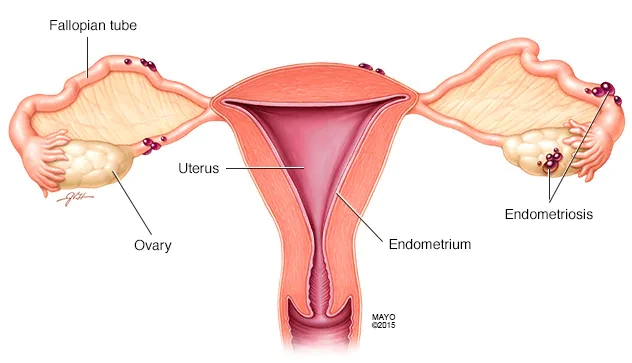Introduction

Endometriosis is a common gynaecological health problem suffered by roughly 5-10% of women. It is a disorder in which endometrial tissues grow outside the uterus giving severe pain and menstrual irregularities (heavy bleeding, clotting etc.).
The endometrial tissues thicken, shed, and bleed each month during the menstrual cycle, and this cycle repeats until the woman gets pregnant or reaches menopause. Due to hormonal imbalances and other factors, sometimes the endometrial tissues appear and flourish outside the uterus in ovaries, fallopian tubes, or intestines. These abnormal tissues follow the same pattern of the menstruation cycle but have no passage to shed. Such women suffer irritation and pain, particularly during the menstrual periods. Eventually, the tissues create scars or adhesions that cause pelvic tissues and organs to stick together. Maa Nursing Home and NetraJyoti Eyecare Centre treats endometriosis with medicines and offers surgery too in severe cases.
Endometriosis develops in stages. Its symptoms can be mild to very severe, including infertility.
What are the symptoms of endometriosis?
- Pelvic pain
- Heavy or long uncontrollable menstrual periods with small or large blood clots
- Premenstrual spotting
- Extreme pain in thighs and legs
- Infertility
- Chronic fatigue
- Constipation or diarrhoea
- Bloating and pain in passing motions
- Occasional fever, headache
- Depression and anxiety

What Causes Endometriosis?
The cause of endometriosis is unknown. But it could be due to
- Retrograde menstruation: One cause is when the endometrial tissues flow backwards from the fallopian tubes into the pelvic and abdominal cavities.
- Coelomic Metaplasia: Another possibility is that areas lining the pelvic organs possess primitive cells that can grow into other forms of tissue, such as endometrial cells
- Transplantation: It is also likely that direct transfer of endometrial tissues during surgery may be responsible for the endometriosis implants sometimes seen in surgical scars (for example, episiotomy or Caesarean section scars)
- Transfer of endometrial cells via the bloodstream or lymphatic system is the most likely explanation for the rare cases of endometriosis that develop in the brain and other organs distant from the pelvis.
- Immune system: Some studies have shown alterations in the immune response in women with endometriosis, which may affect the body’s natural ability to recognize and destroy any misdirected growth of endometrial tissue.
What treatment is available for endometriosis?
We prescribe medicines for pain relief. Hormone-suppressing drugs are given in oral or in injection form. These medicines help in relieving pain and preventing the growth of endometriotic implants. Also, these medicines help prevent ectopic pregnancy.
In severe cases, particularly those women who cannot conceive due to endometriosis, the doctor may suggest Laparoscopy surgery. It helps remove all implants, resect adhesions (separate the stuck organs and tissues), relieve pain, reduce the risk of recurrence and adhesion formation, and restore the normal anatomy and physiology.
Laparoscopy provides better visualization and leads to faster recovery with more success rate for pregnancy.